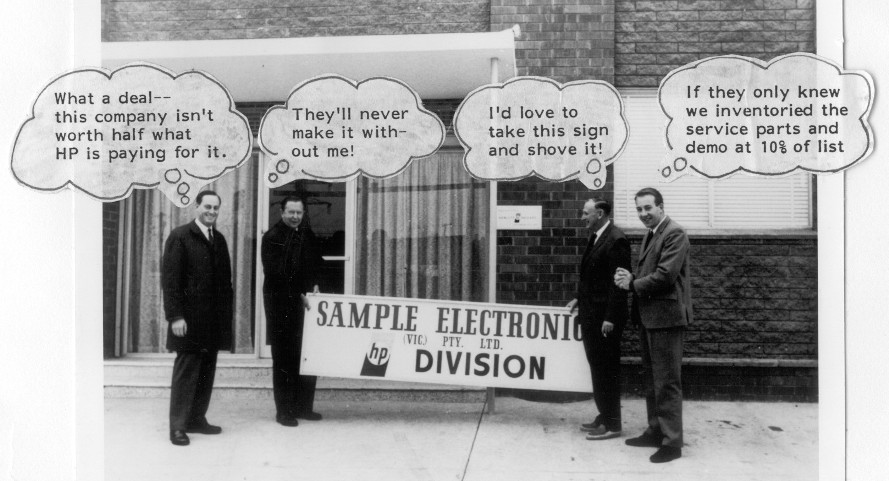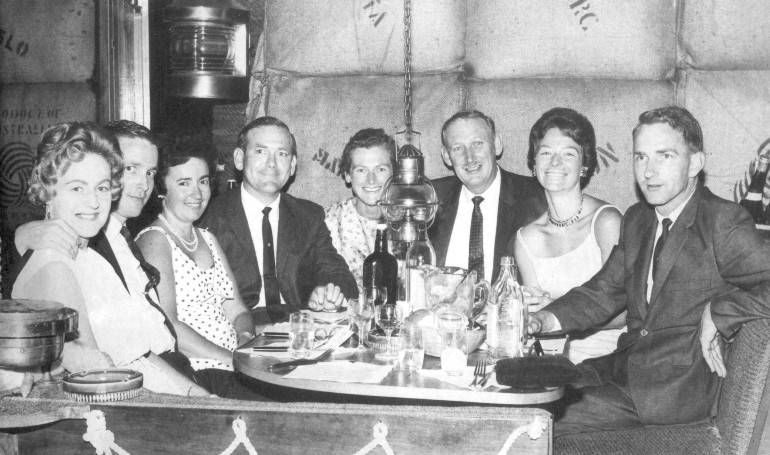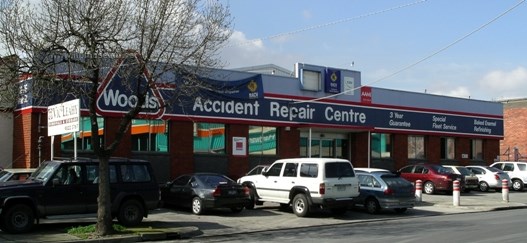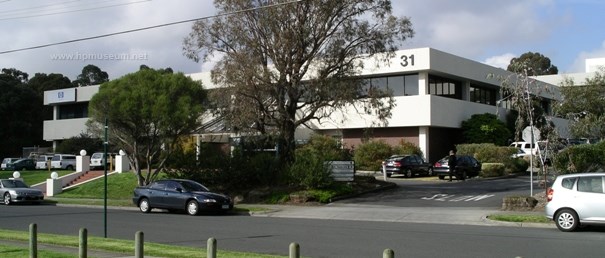History
From its inception, Hewlett-Packard used independent manufacturer’s representative sales organizations to sell its products in the USA. HP did not have a dedicated sales force. Internationally, HP used distributors to sell its instruments. Beginning in 1962, HP began developing its own dedicated sales force in the USA (primarily through the purchase of existing manufacturer's representative companies) and started setting up company-owned offices overseas. In most cases, HP bought the HP distribution business (including employees and offices) from the local country distributor. That is what happened in Australia in 1967.
HP products were distributed by Melbourne-based Sample Electronics from the 1940s until HP bought the business on July 1, 1967. Twenty-nine employees made the transition from Sample to HP, including the general manager John Warmington, HP's first managing director in Australia. John had been in the industry for a long time and had sold the first HP instrument delivered in Australia in 1947. Most staff worked in the Melbourne suburb of Glen Iris. A few were based in the Sydney branch office.
To view the HP Australia organisation chart of December, 1968, click here. The chart of only 50 people includes three of the first five managing directors to lead HP Australia in its first 34 years.
The first directors of Hewlett Packard Australia Pty Ltd were K E Tingley, J A Warmington, W P Doolittle and C C Trumble. In 1981, HP Australia became a public company and the name changed to Hewlett Packard Australia Ltd.
HP had sales of $2,000,000 during that first year of operation. By 1977, annual sales grew to $25,000,000 with 240 employees on staff. In 1986, HP's annual sales reached $163,000,000 and staff totalled 650 employees. HP Australia turnover reached $366M in 1992 with staff of 700. By the end of the decade, annual revenue grew to $1.62B, including $320M in export revenue.
 |
 |
|
|
R to L: Barry Sutton and John Warmington return the Sample Electronics sign to George Sample |
L to R: At the deal consummation dinner: Dianne Barlow, Alan Bickel, Joan Warmington, Derek Barlow, |
HP opened offices throughout Australia soon after the acquisition of Sample. The Adelaide office was opened in October, 1967 in a converted fish and chips shop. The Perth office was opened in 1969. HP's first branch manager in Canberra, Dick Graf, worked out of his home for two months before the Canberra office was opened in December, 1969. HP started its Brisbane operation in 1971 when a field engineer was transferred from the Sydney office. He worked from home until HP opened its official office in November, 1972. By 1974, HP was bursting out of its Melbourne headquarters building and moved to a custom-built facility in the suburb of Blackburn . HP's Australasian headquarters remained in Blackburn until the Compaq acquisition in 2002. In June of 1980, HPA moved its Sydney office into a custom-built 4000 square meter building in the surburb of North Ryde.
In March of 1975, HP New Zealand won the largest ever single order for HP computer systems. The order was worth approximately $3M and included 41 2100 computers as well as 192 2640 terminals. The customer was the New Zealand State Services Commission. The order was very easy to fill as it consisted entirely of standard HP equipment and required no integration with third party products.

HP Australia headquarters, Glen Iris (Melbourne), 1967 – 1974

HP Australia Headquarters, Blackburn (Melbourne), 1974 – 2002
Throughout its life, HP Australia (HPA) has primarily been a sales and distribution organisation. As in many countries, HP's chances of winning government business in Australia could be greatly enhanced by providing more local value-add in either R&D or manufacturing. HP Australia has engaged in many activities to fulfill this requirement. Beginning in the mid 1960s, HPA began assembling 200CD oscillators for local sales and for export. Beginning in 1984, HPA also made HP-IB cables locally. In the 1980s, HP's primary local value-add took the form of the Australian Software Operation (ASO), based in Ringwood, Victoria. The ASO was established in 1984. By corporate edict, this operation was discontinued in 1990. HPA's government business faced uncertainty over the following year due to the confusion over the closure of the ASO. HP's most significant Australian initiative was the Australian Telecom Operation of the 1990s. All worldwide design and manufacturing of HP's high-end telecommunications test equipment took place in Melbourne. By the end of the decade, this business was exporting over $100,000,000 annually. Agilent took the telecommunications business when the companies split in 1999. HP's handheld calculator business (including manufacturing) moved to Melbourne in 1997, where it remained until 2001. The general manager of the Australian Calculator Operation (ACO) was Chris Wallin.
HP's acquisition of Compaq in 2002 radically changed the organization of HP Australia. The Australian operation of Digital Equipment Corporation was one of that company’s star global performers in the 1990s. Although Compaq was also a strong performer in Australia, it was dwarfed by DEC when DEC was acquired in 1998. A similar situation occurred when HP bought Compaq in 2002. Compaq was more than twice the size of HP at the time. In the final new management structure, former Compaq employees won three of the top four management positions in the merged entities. The printer business was the only operation to be headed by an incumbent HP employee (Rebekah O’Flaherty). In late 2002, HP's Australasian headquarters moved from Melbourne to the former Compaq headquarters in Sydney. In 2012, HP vacated the Blackburn facility.
For more detail on the history of HP in Australia and New Zealand, Please visit the museum's collection of Depth Magazine.
Facility photos are courtesy of BGImages Australia. Historic photos are courtesy of Hewlett Packard Australia Ltd.
| Back |
^ TOP©2004 - 2024 BGImages Australia - All Rights Reserved.
The HP Computer Museum and BGImages Australia are not affiliated with HP Inc. or with Hewlett Packard Enterprise. Hewlett Packard and the HP logo are trademarks of HP Inc and Hewlett Packard Enterprise. This website is intended solely for research and education purposes.
